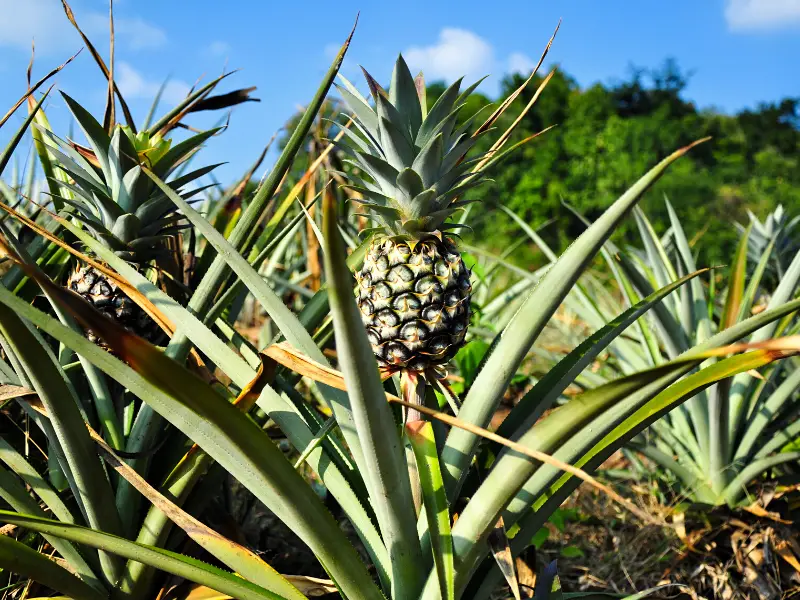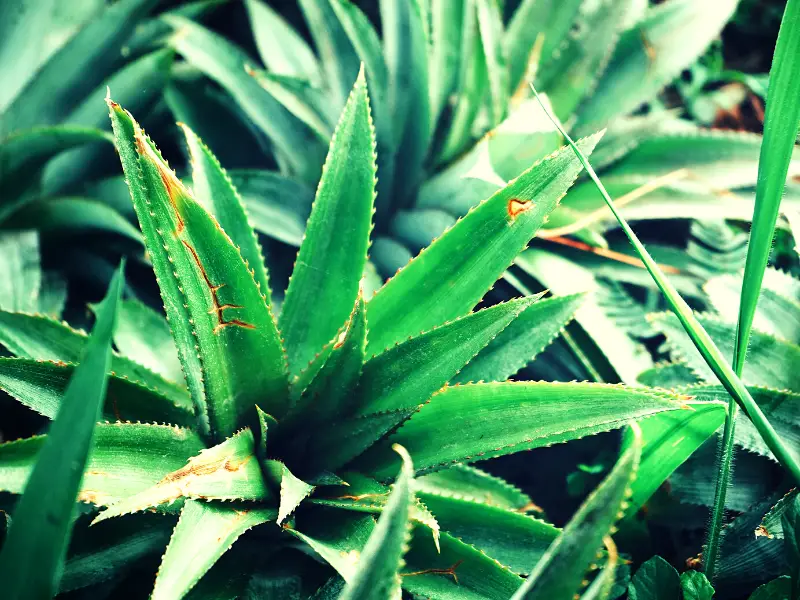‘Pineapple leather,’ also known as Piñatex, is manufactured from the fruit’s leaves. It’s significantly more environmentally friendly than both cow skin leather and traditional synthetic leather, plus it looks stunningly good.
Today we’re taking a look at the material. What is pineapple leather? Is it a green alternative to conventional leather? How is pineapple leather made? We’ll examine all the answers to these questions and more.
What Is Piñatex?
Piñatex is a woven, coated pineapple textile. It’s manufactured all over the Philippines, with some operations in Europe. Also, unlike regular synthetic leather, there are no fossil fuels used to produce pineapple leather.

Piñatex is a significantly more environmentally friendly alternative to cow skin leather, especially considering that 98% of cow leather is tanned with chromium. Piñatex does not contain any toxic chemicals or heavy metals, so it’s more comfortable for those who suffer from allergies or have delicate skin. It has exceptional durability and requires little maintenance.
How Is Pineapple Leather Fabric Made?
The pineapple leather is manufactured from the leaves of the tropical pineapple plant. These aren’t the leaves that stick out of the pineapple, but rather the leaves of the plant itself, which are most commonly thrown away before we ever get to see them in their full glory.

The fibers of the pineapple leaves are separated, dried, and then joined together in a processing method that generates a non-woven substrate. Essentially, a flat fabric sheet, similar to felt, all the distinct leaf fibers pass over each other and fuse together. The end product is biodegradable.
After this phase, the pineapple fiber is covered with a protective layer. This coating accounts for between 10-15 percent of the final material, making it still essentially an alternative to leather in terms of functionality.
Because it is formed of polylactic acid, the coating contains a small amount of plant material. This type of thermoplastic is created from renewable biomass, such as fermented plant starch derived from corn, sugarcane, or sugar beet, among other sources.
The global pineapple industry typically generates approximately 13 million tonnes of trash per year, most of which are ordinarily thrown leaves. Piñatex reprocesses this waste by creating a sustainable leather substitute from it, and the company does not require any extra agricultural land for its production.

The Impact of Pineapple Leather
By purchasing Pinatex, a natural, vegan leather alternative, we help provide a consistent source of additional revenue for pineapple growers in the Philippines, who benefit from the increased demand for their products. Instead of producing only fruit, they grow both fruit and leaves for a profit, which is then reinvested back into their community and family members.
Most leather we buy nowadays comes from large industrial farms, regularly owned by large corporations. When these cattle farms sell their calves to slaughterhouses, their skins are sold for a profit. We don’t think of it constantly, but we help fund the exploitation and slaughter of these sentient beings by buying their skins.
Livestock dehorning without anesthetics is a cruel but legally practice on most cattle farms. This means their horns are chopped or burned off their heads at any age. Male calves don’t produce milk, so their only use is to be grown for meat and leather while only a small minority of them will become insemination bulls. Most of the time they will be slaughtered at a few days old, however.
Interestingly, when abattoirs have been unable to market out the skins, as it has happened in some cases due to rising demand for vegan leather alternatives, they have claimed to have lost millions of dollars in profit.
If slaughterhouses do not generate enough revenue, they will cease operations. These are some essential things to be aware of: what we spend our money on makes a difference to the world.
Is Pineapple Leather a Sound, Long-Term, Sustainable Alternative?
The Sustainable Apparel Coalition gives data and provides a numerical rating to the environmental impact of textile materials through its Material Sustainability Index. The greater the number, the more harmful the material to the environment.
According to recent data from 2020, cow skin leather is the third most environmentally damaging material to create. Previously, it was believed to be the most impactful, but silk and alpaca wool have been evaluated further, and those are now ranked first and second in terms of detrimental environmental impact.
There is less environmental impact with even PU synthetic leather than with cow skin leather. Piñatex has about half the effect of PU synthetic leather. This shows that cow skin leather is entirely unsustainable and that more natural vegan leather substitutes such as Piñatex are the best choices for anyone concerned about the planet’s future.
Cowskin leather has a significant environmental impact because animal agriculture is so damaging to the world. Through enteric fermentation, cattle generate large volumes of greenhouse gas emissions. This process, essentially the passage of gas, results in significant methane emissions. These greenhouse gas emissions from animal agriculture are similar to the emissions emitted by the transportation industry through all exhaust from every plane, train, automobile, and boat on the planet.
Additionally, leather is exceptionally thirsty, requiring 17,100 liters of water to produce a kilogram of skin. This is not even the overall water footprint of cattle husbandry; instead, the water is linked with the weight of the cow attached to its skin.
FAQs About Piñatex
- Is Piñatex biodegradable?
- Yes! Piñatex is 90% biodegradable, a quality that maximizes the product’s ecological benefit. This is because the material comprises around 90 percent pineapple leaves and approximately 10 percent renewable biomass resin covering.
- What does Piñatex feel like?
- Piñatex feels like genuine leather. The texture is smooth when you touch it, and you have the impression of touching classic leather. However, unlike natural leather, Piñatex does not smell bad and does not feel greasy or sticky. Piñatex has a fresh, natural scent.
- How durable is Pineapple leather?
- With the proper care, Pineapple leather is very durable as it is designed to be very resistant to wear. Since it is made of pineapple leaves, it is extremely strong. As such, this sustainable material can withstand rain and ultraviolet radiation while maintaining a nice look and feel.
Guides to a Sustainable Lifestyle and Eco-Friendly Advice: Compostable Bags, Eco Mist Hardwood Cleaner, Biotrem
Author’s Note
The leather industry is one of the most wasteful industries in the world. So Pineapple leather makes much better alternative to animal leather.
We hope this article helps you learn more about pineapple leather and helps you make a more educated decision for your future purchases!


2 thoughts on “Piñatex: An Eco-Friendly Alternative to Animal Leather”